.gif)
Mile End (Montreal)
Encyclopedia
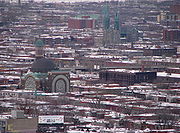
Montreal
Montreal is a city in Canada. It is the largest city in the province of Quebec, the second-largest city in Canada and the seventh largest in North America...
, Quebec
Quebec
Quebec or is a province in east-central Canada. It is the only Canadian province with a predominantly French-speaking population and the only one whose sole official language is French at the provincial level....
, Canada
Canada
Canada is a North American country consisting of ten provinces and three territories. Located in the northern part of the continent, it extends from the Atlantic Ocean in the east to the Pacific Ocean in the west, and northward into the Arctic Ocean...
.
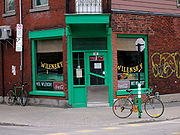
Le Plateau-Mont-Royal
Le Plateau-Mont-Royal is a borough of the city of Montreal, Quebec, Canada.The Plateau-Mont-Royal takes its name from its location on relatively flat terrain north of Sherbrooke Street and downtown, and east of Mont-Royal...
borough in terms of Montreal's municipal politics. Local residents make a distinction between Mile End, a highly multicultural district with a mix of Anglophone
English language
English is a West Germanic language that arose in the Anglo-Saxon kingdoms of England and spread into what was to become south-east Scotland under the influence of the Anglian medieval kingdom of Northumbria...
and Francophone
Francophone
The adjective francophone means French-speaking, typically as primary language, whether referring to individuals, groups, or places. Often, the word is used as a noun to describe a natively French-speaking person....
populations, and the eastern parts of the Plateau borough, which have primarily Francophone populations.
Description
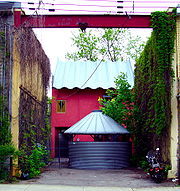
English language
English is a West Germanic language that arose in the Anglo-Saxon kingdoms of England and spread into what was to become south-east Scotland under the influence of the Anglian medieval kingdom of Northumbria...
culture and as an artistic neighbourhood, home to artists, musicians, writers, and filmmakers such as Arcade Fire, Adam Gollner
Adam Gollner
Adam Leith Gollner is a writer and musician who lives in Montreal, Canada.Gollner's first book, The Fruit Hunters: A Story of Nature, Adventure, Commerce and Obsession was published by Charles Scribner's Sons in the U.S., Doubleday in Canada, and Larousse in Brazil.Gollner was the former editor of...
, Grimes, Sean Michaels
Sean Michaels (writer)
Sean Michaels is a Canadian journalist, fiction writer, and blogger. Based in Montreal, Quebec, his writing has appeared in such publications as McSweeney's, The Believer, Pitchfork, The Guardian, Brick, Maisonneuve and The National Post. Michaels is also one of the founders of Said the Gramophone...
and Plants and Animals
Plants and Animals
Plants and Animals are a Canadian indie-rock band from Montreal which comprises guitarist-vocalists Warren Spicer and Nic Basque and drummer-vocalist Matthew Woody Woodley. They often describe their music as post-classic rock. They are signed to Secret City Records...
, etc. Many art galleries, designers' workshops, boutiques and cafés are found here. The computer graphics software house Discreet Logic made a mark on the area by renovating part of an old clothing factory in the early 1990s. In 1997, this space became the new Montreal studios of computer game developer Ubisoft
Ubisoft
Ubisoft Entertainment S.A. is a major French video game publisher and developer, with headquarters in Montreuil, France. The company has a worldwide presence with 25 studios in 17 countries and subsidiaries in 26 countries....
, expanded since to take over much of the building. Mile End has become noticeably richer and more popular since the mid-90s: rents have increased
Gentrification
Gentrification and urban gentrification refer to the changes that result when wealthier people acquire or rent property in low income and working class communities. Urban gentrification is associated with movement. Consequent to gentrification, the average income increases and average family size...
and shops have become more upscale.
The writer Mordecai Richler
Mordecai Richler
Mordecai Richler, CC was a Canadian Jewish author, screenwriter and essayist. A leading critic called him "the great shining star of his Canadian literary generation" and a pivotal figure in the country's history. His best known works are The Apprenticeship of Duddy Kravitz, Barney's Version,...
grew up on Saint-Urbain Street in the 1930s and 40s, and wrote about the neighbourhood in several of his novels. Wilensky's Light Lunch, which is still open on Fairmount at Clark, features memorably in The Apprenticeship of Duddy Kravitz
The Apprenticeship Of Duddy Kravitz (book)
The Apprenticeship of Duddy Kravitz is the fourth novel by Canadian author Mordecai Richler. It was first published in 1959 by André Deutsch, then adapted to the screen in 1974.-Plot and setting:...
and the film based on it. William Shatner
William Shatner
William Alan Shatner is a Canadian actor, musician, recording artist, and author. He gained worldwide fame and became a cultural icon for his portrayal of James T...
grew up in Mile End until he moved to Notre-Dame-de-Grâce
Notre-Dame-de-Grâce
Notre-Dame-de-Grâce , also nicknamed NDG, is a residential neighbourhood of Montreal located in the city's west-end. It is one of five districts of the borough of Côte-des-Neiges–Notre-Dame-de-Grâce...
during his high school years.
In 2005, Mile End was described in several music magazines, notably Spin
Spin (magazine)
Spin is a music magazine founded in 1985 by publisher Bob Guccione Jr.-History:In its early years, the magazine was noted for its broad music coverage with an emphasis on college-oriented rock music and on the ongoing emergence of hip-hop. The magazine was eclectic and bold, if sometimes haphazard...
and Pitchfork Media
Pitchfork Media
Pitchfork Media, usually known simply as Pitchfork or P4k, is a Chicago-based daily Internet publication established in 1995 that is devoted to music criticism and commentary, music news, and artist interviews. Its focus is on underground and independent music, especially indie rock...
, as the heart of the independent music scene in Montreal. Several venues on Saint-Laurent Boulevard have contributed to the development of the local scene, including Casa del Popolo
Casa del Popolo
Casa del Popolo is a notable bar, bistro, and music venue in Montreal, on Saint Laurent Boulevard. Its name is Italian for "House of the People".It was established in September 2000 by Mauro Pezzente and his partner Kiva Stemic...
, the Sala Rossa, El Salon (now closed), and The Green Room (Le Salon Vert, recently burned down). In the 1980s there were Checkers and Club Soda on Park Avenue. Many indie labels such as Arbutus Records
Arbutus Records
Arbutus Records is a Montreal based record label and arts community. The community began as a 4600 square foot Mile End loft space called Lab Synthèse; the label itself was created in order to cultivate and promote the bands associated with the space...
, Dare to Care Records
Dare to Care Records
Dare to Care Records is a Canadian independent record label. Based in Montreal, the label was founded by Éli Bissonnette and Hugo Mudie. The label maintains two separate imprints, Dare to Care for anglophone and francophone artists promoted across Canada and internationally, and Grosse Boîte for...
/ Grosse Boîte, Bonsound
Bonsound
Bonsound is a Montreal-based company that manages, books and promotes music. Bonsound also houses three records labels: Bonsound Records, Blow The Fuse Records and Proxenett.-History:...
, Indica Records
Indica Records
Indica Records is a Canadian record label based in Montreal, Quebec, founded by rock band Grim Skunk in 1997. The label was put together by the band, manager Simon Gallipeault, label manager Kyria Kilakos and head of promo Mariana Gianelli. Indica is considered to be the biggest "alternative"...
, Mindique, Constellation Records
Constellation Records
Constellation Records is an influential Montreal, Quebec independent record label known for its contributions to experimental genres of music. It is most famous for releasing the albums of Godspeed You! Black Emperor, Thee Silver Mt. Zion Memorial Orchestra & Tra-La-La Band, and Do Make Say...
and the famous hotel2tango
Hotel2Tango
The Hotel2Tango is a 24-track analogue recording studio situated in the Mile End district of Montreal, Quebec. The current facility is the second to bear the name, and was preceded by a similar operation in the same neighborhood until 2007 when the studio changed locations...
recording studio are also located in the Mile End. Independent record label Mile End Records
Mile End Records
Mile End Records is an independent record label based in Montreal, Canada. It was started in 2005 by Producer/DJ Patrick Dream and MIXART Studios' Kirk Coleman...
is also named after the neighbourhood as one of the founders once lived there.
The area is also home to the city's two most famous bagel bakeries, Fairmount Bagel
Fairmount Bagel
Fairmount Bagel is the original Montreal bagel bakery in Montreal, Quebec, Canada.It was opened by 1919 by Russian immigrant Isadore Shlafman, whose hand-rolled recipe quickly became a staple in the Mile End community...
and St-Viateur Bagel
St-Viateur Bagel
St-Viateur Bagel is a famous Montreal-style bagel bakery located in the neighbourhood of Mile End in the borough of Le Plateau Mont-Royal. Established in 1957 by Myer Lewkowicz, the bakery takes its name from its street, St-Viateur Street...
.
The well known local brewpub Dieu du Ciel (God of Heaven) on Laurier Street West, immortalized the area with two beers. One called Mild End, an English-style mild ale. The other is Saison St-Louis, named after the neighbourhood's first name, Saint-Louis-du-Mile-End, a Belgian-style saison.
Streets
The main streets running through Mile End from north to south are Saint-Laurent BoulevardSaint Lawrence Boulevard
For the Ottawa road, see St. Laurent Boulevard. For the Gatineau road called "Boulevard Saint-Laurent", see Boulevard des Allumettières.Saint Lawrence Boulevard or boulevard Saint-Laurent is a major street in Montreal, Quebec, Canada...
, Clark Street, Saint Urbain Street
Saint Urbain Street
St. Urbain Street is a major one-way street located in Montreal, Quebec, Canada. The street has historically been home to Montreal's well-established Jewish community, who settled in the area at the turn of the 20th century. Writer Mordecai Richler often documents what life was like on this street...
, Esplanade Street, Jeanne-Mance Street, and Park Avenue. Running east to west are Mount Royal Avenue
Mount Royal Avenue
Mount Royal Avenue is a street in Montreal. The main part of the street transects the borough of Le Plateau-Mont-Royal, from Park Avenue at the foot of Mount Royal, for which the road is named, to rue Frontenac. Another section in Rosemont–La Petite-Patrie runs from rue Molson to Pie-IX Boulevard...
, Villeneuve Street, St Joseph
Saint Joseph Boulevard
Saint Joseph Boulevard is a major boulevard located east of Mount Royal in Montreal, Quebec, Canada. It is mainly residential, but is nevertheless a major east-west artery. It is located in the Plateau Mont-Royal and the Rosemont–La Petite-Patrie boroughs...
, Laurier, Fairmount, Saint Viateur, Bernard and Van Horne.
Origins
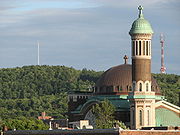
Saint Lawrence Boulevard
For the Ottawa road, see St. Laurent Boulevard. For the Gatineau road called "Boulevard Saint-Laurent", see Boulevard des Allumettières.Saint Lawrence Boulevard or boulevard Saint-Laurent is a major street in Montreal, Quebec, Canada...
) and what is now Mount Royal Avenue. Originally, this road was Côte Sainte-Catherine Road (heading west) and Côte Saint-Louis Road (heading east); later, a stretch of this road was known as Mile End Road. It is probable that the name Mile End was inspired by the East London suburb of the same name
Mile End
Mile End is an area within the East End of London, England, and part of the London Borough of Tower Hamlets. It is located east-northeast of Charing Cross...
. Contrary to popular belief, the place is not precisely a mile away from any official marker. It is, however, a mile north along Saint Lawrence Road from Sherbrooke Street. Furthermore it was 1 miles (1.6 km) along Saint Lawrence from Mount Royal Avenue (the Southern limit of the village) to the Mile End train station near Bernard street. In essence, the "Mile End" starts precisely where the "Golden Square Mile" ends.
Mile End was also the first important crossroads north of the tollgate located at the city limits of 1792. From the crossroads to the city limits the distance was 0.4 mile (0.643736 km). The city limits were located 100 chains
Chain (unit)
A chain is a unit of length; it measures 66 feet or 22 yards or 100 links . There are 10 chains in a furlong, and 80 chains in one statute mile. An acre is the area of 10 square chains...
(1.25 miles or about 2 km) north of the fortification wall, and intersected Saint Lawrence just south of the current Duluth Avenue.
As early as 1815, there was a Mile End Hotel and tavern, frequented by notables such as Stanley Bagg, an English businessman and landowner. The earliest known printed references to Mile End are advertisements placed by Stanley Bagg, in both English and French, in The Gazette
The Gazette (Montreal)
The Gazette, often called the Montreal Gazette to avoid ambiguity, is the only English-language daily newspaper published in Montreal, Quebec, Canada, with three other daily English newspapers all having shut down at different times during the second half of the 20th century.-History:In 1778,...
during the summer of 1815. He announced in July: "Farm for sale at St. Catherine
STRAYED or STOLEN from the Pasture
of Stanley Bagg, Mile End Tavern, on or about the
end of June last, a Bay HORSE about ten years old, white
face, and some white about the feet. Any person who will
give information where the Thief or Horse may be found
shall receive a reward of TEN DOLLARS and all reasonable
charges paid. STANLEY BAGG.
Montreal, Mile End, August 4, 1815.
A Notman
William Notman
William Notman was a Canadian photographer and businessman.Notman was born in Paisley, Scotland in 1826, the same year in which photography was born in France. William Notman moved to Montreal in 1856. An amateur photographer, he quickly established a flourishing professional photography studio on...
photo of 1859 shows members of the Montreal Hunt Club setting out from Mile End Road.
Sections of Côte Saint Louis Road became known as Chemin des Tanneries (Tannery Road) and Chemin des Carrières (Quarry Road) because the road led to a tannery and to limestone quarries used for the construction of much of Montreal's architecture. The village of Côte Saint-Louis (incorporated 1846) sprung up near the quarries, its houses clustered east of the Mile End district around the present-day intersection of Berri Street and Laurier Avenue. It was to serve this village that a chapel of the Infant Jesus was established in 1848 near Saint Lawrence Road, on land donated by Pierre Beaubien
Pierre Beaubien
Pierre Beaubien was a physician and political figure in Canada East.He was born in Baie-du-Febvre in 1796 and studied at the Séminaire de Nicolet and the Petit Séminaire de Montréal. He went to France, where he studied at the Académie de Paris and later became a doctor in 1822...
. In 1857-8, the chapel was replaced by the church of Saint Enfant Jésus du Mile End. The church, made even more impressive by a new façade in 1901, was the first important building in what would become Mile End.
The coming of the railway
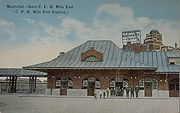
Dalhousie Station (Montreal)
Dalhousie Station is a former railway station in Montreal. Built in 1884, it still stands at the corner of Rue Notre-Dame Est and Rue Berri in east end Montreal...
(in the east end of the old fortified city) to Sainte-Thérèse
Sainte-Thérèse, Quebec
Sainte-Thérèse is an off-island suburb northwest of Montreal, in southwestern Quebec, Canada, in the Regional County Municipality of Thérèse-de-Blainville....
, Lachute, and Ottawa
Ottawa
Ottawa is the capital of Canada, the second largest city in the Province of Ontario, and the fourth largest city in the country. The city is located on the south bank of the Ottawa River in the eastern portion of Southern Ontario...
. This railway was bought in 1882 by the Canadian Pacific
Canadian Pacific Railway
The Canadian Pacific Railway , formerly also known as CP Rail between 1968 and 1996, is a historic Canadian Class I railway founded in 1881 and now operated by Canadian Pacific Railway Limited, which began operations as legal owner in a corporate restructuring in 2001...
, and it was by this route that the first trains departed for the Prairies
Canadian Prairies
The Canadian Prairies is a region of Canada, specifically in western Canada, which may correspond to several different definitions, natural or political. Notably, the Prairie provinces or simply the Prairies comprise the provinces of Alberta, Saskatchewan, and Manitoba, as they are largely covered...
in 1885 and for Vancouver
Vancouver
Vancouver is a coastal seaport city on the mainland of British Columbia, Canada. It is the hub of Greater Vancouver, which, with over 2.3 million residents, is the third most populous metropolitan area in the country,...
in 1887. Mile End Station was established in 1878 on the east side of Saint-Laurent Road, near what is now the intersection of Bernard Street. (A much larger station was built in 1911; it closed in 1931, when service was moved to the new Park Avenue Station (Jean-Talon), and was demolished at the end of the 1960s to make way for the Rosemont–Van Horne viaduct.)
The same year the railway station opened (1878) the village of Saint-Louis-du-Mile-End was incorporated, population 1319. Its territory consisted of the western third of Côte Saint-Louis: bounded on the west by the limit of Outremont (generally along Hutchison Street), on the south by what is now Mont-Royal Avenue, and on the east by a line running mostly just east of the current Henri-Julien Avenue. The northern border was north of present-day De Castelnau Street or just south of Jarry Park.
Growth and annexation
The second growth spurt of Mile End coincided with the electrification of tramway service in 1893; the area can be considered an example of a streetcar suburbStreetcar suburb
A streetcar suburb is a residential community whose growth and development was strongly shaped by the use of streetcar lines as a primary means of transportation. Early suburbs were served by horsecars, but by the late 19th century cable cars and electric streetcars, or trams, were used, allowing...
. The agricultural and industrial exhibition grounds at the southwest of the village, near Mount Royal
Mount Royal
Mount Royal is a mountain in the city of Montreal, immediately west of downtown Montreal, Quebec, Canada, the city to which it gave its name.The mountain is part of the Monteregian Hills situated between the Laurentians and the Appalachians...
, were subdivided for housing. The village became a town in 1895 and changed its name to simply Saint-Louis. Apart from a tiny street located just outside the town's northwestern limit, and (for its remaining years) the railway station, the name Mile End passed out of the official toponymy for close to a century, coming back into use as a municipal electoral district only in the 1980s.
The town of Saint-Louis built in 1905 a magnificent town hall on the northwest corner of Saint-Laurent and what is now Laurier Avenue; the building still serves as a fire hall and firefighters' museum. The town was annexed by the expanding city of Montreal on 29 May 1909, taking effect as of 1 January 1910, and became Laurier Ward (quartier Laurier). Population growth had been explosive: in 1891, the village had 3537 residents; in 1911, after annexation, the ward's population was about 37,000.
Perhaps the most recognizable architectural symbol of Mile End is the Church of St. Michael and St. Anthony
Church of St. Michael and St. Anthony
The Church of St. Michael and St. Anthony is a Roman Catholic church located in Mile End, Montreal. It was originally built as the Church of St. Michael and frequented by Irish Catholics. Because of the growth of the Polish community in the area, in 1964 a Polish mission was inaugurated in the...
of 1914-5, on Saint-Viateur Street at the corner of Saint-Urbain. The church was built for a largely Irish Catholic community, as expressed by omnipresent shamrock motifs; yet the overall style of the building borrows more from the Byzantine than Western architectural traditions. Even more striking, the church has a slender tower that resembles a minaret. The building is now shared with the Polish Catholic parish of St. Anthony and masses are given in several languages.
Twentieth-century evolution
The ethnic composition of Mile End changed constantly over the course of the twentieth century as the area became home to successive waves of new immigrants. Marianne AckermanMarianne Ackerman
Marianne Letitia Ackerman is a Canadian novelist, playwright, and journalist. Piers' Desire, her third and most recent novel, was published in 2010.- Life and career :...
's series of articles on her 100 year old house gives a vivid picture of the changing vocation of the neighbourhood.
The southern half of Mile End was first a bourgeois suburb, then Montreal's principal Jewish area until the 1950s (later made famous by Mordecai Richler
Mordecai Richler
Mordecai Richler, CC was a Canadian Jewish author, screenwriter and essayist. A leading critic called him "the great shining star of his Canadian literary generation" and a pivotal figure in the country's history. His best known works are The Apprenticeship of Duddy Kravitz, Barney's Version,...
and others) and later home to Greek and Portuguese communities, among others. The Hassidic
Hasidic Judaism
Hasidic Judaism or Hasidism, from the Hebrew —Ḥasidut in Sephardi, Chasidus in Ashkenazi, meaning "piety" , is a branch of Orthodox Judaism that promotes spirituality and joy through the popularisation and internalisation of Jewish mysticism as the fundamental aspects of the Jewish faith...
community has reestablished a visible Jewish presence in the Mile End and in neighbouring Outremont. After gaining a reputation as a neighbourhood of artists and musicians in the 1980s, the area has undergone gentrification
Gentrification
Gentrification and urban gentrification refer to the changes that result when wealthier people acquire or rent property in low income and working class communities. Urban gentrification is associated with movement. Consequent to gentrification, the average income increases and average family size...
since the late 1990s.
The area north of the railway, rarely referred to as Mile End any more, developed separately since the rail corridor interrupts many north-south streets. Early twentieth century immigrants from Italy settled here creating Montreal's Little Italy
Little Italy, Montreal
Montreal's Little Italy is located on Saint Laurent Boulevard between Jean-Talon and St. Zotique Streets and is home to one of Montreal's original Italian Canadian communities...
. The city's largest remaining public market, Jean Talon Market, opened here in 1933.
Parts of Mile End were heavily industrialized in the first half of the century because of the proximity of transportation by rail. Much of Mile End served as the heart of Montreal's garment district
Garment District, Montreal
The Garment District is a neighbourhood in the city of Montreal, Quebec, Canada. It is located primarily along Chabanel Street in the Ahuntsic neighbourhood of the Ahuntsic-Cartierville borough. The Chabanel Station is located close by.- History :...
for many decades.
Municipal electoral reform in 1978 replaced the old wards with smaller, more uniformly sized districts and further reform in the 1980s grouped districts into boroughs (arrondissements). Within the borough of Plateau Mont Royal/Centre-Sud
Le Plateau-Mont-Royal
Le Plateau-Mont-Royal is a borough of the city of Montreal, Quebec, Canada.The Plateau-Mont-Royal takes its name from its location on relatively flat terrain north of Sherbrooke Street and downtown, and east of Mont-Royal...
, the name Mile End was revived for a district covering essentially the part of the old Laurier Ward lying south of the railway tracks. This is the area that is now generally associated with the name. The electoral district was expanded eastward to Saint Denis Street in 2001 (the borough having been renamed Le Plateau Mont Royal) and as far as Laurier Park in 2005, so that it now includes the historic centre of the village of Côte Saint-Louis. Most of the former northern half of Saint Louis du Mile End now lies within the Saint Édouard district of the borough of Rosemont–La Petite-Patrie
Rosemont–La Petite-Patrie
Rosemont–La Petite-Patrie is a borough in the city of Montreal, Quebec, Canada. It is located in the centre-east of the city.-Geography:...
.
External links
- des citoyens du Mile-End
- Welcome to Mile End, by Christopher DeWolf (photo essay)
- The United Neighbourhoods of Mile End, by Christopher DeWolf
- Images of Mile-End district on IMTL.org
- Société d’histoire et de généalogie du Plateau-Mont-Royal (historical society; in English and French)
- The Archangel of Mile-End, by Jorge Pomalaza Ráez (photo)
- La neige du quartier Mile-End, by Jorge Pomalaza Ráez (photo)
- Plateau Mont-Royal history blog
- MILEENDMONTREAL.COM
- Mile End three-part series by Marianne Ackerman, in The Gazette, Montreal

